“It is not the critic who counts; not the man who points out how the strong man stumbles, or where the doer of deeds could have done them better. The credit belongs to the man who is actually in the arena, whose face is marred by dust and sweat and blood; who strives valiantly; who errs, who comes short again and again, because there is no effort without error and shortcoming; but who does actually strive to do the deeds; who knows great enthusiasms, the great devotions; who spends himself in a worthy cause; who at the best knows in the end the triumph of high achievement, and who at the worst, if he fails, at least fails while daring greatly, so that his place shall never be with those cold and timid souls who neither know victory nor defeat.” – Theodore Roosevelt
Reflections and Calls to action from the convening of the National Superintendent Roundtable
Atlanta, Georgia – October 14-16, 2022 – #NSR2022
Education for Democracy is the theme of this year’s Roundtable conference. There is a sense of urgency now for the P-20/K-12 school leaders to advance the purposes, successes, stories, and narrative of Public Education. This convening of superintendents and business partners from across the USA was another engaging, inspiring, and motivating set of discussions, thought leaders provoking discomfort, and true leadership challenges in a safe, inviting, and inspirational location.
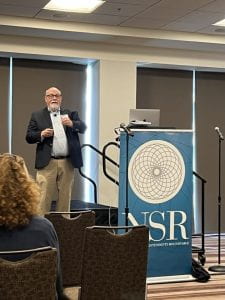 American demographics are shifting, and the American need for civics and history is more pronounced now than possibly at any time in our history; privatization forces threaten not only public schools but the nation itself; it’s incumbent upon us to amplify the narrative of public education and tell our stories! In this blog post, I share notes, thoughts, and reflections. I also share some calls to action for myself and us all. It’s possible that our way of life depends on this!
American demographics are shifting, and the American need for civics and history is more pronounced now than possibly at any time in our history; privatization forces threaten not only public schools but the nation itself; it’s incumbent upon us to amplify the narrative of public education and tell our stories! In this blog post, I share notes, thoughts, and reflections. I also share some calls to action for myself and us all. It’s possible that our way of life depends on this!
From time to time, I write about and reflect upon “what a superintendent does” since there are not too many of us in consideration of the overall educational community. We are multi-faceted, complex leaders faced with dynamic challenges woven into the tapestry of our nation, our states, our regions, our towns, and of course, our school districts/organizations/divisions.
What is “now” that is needed is clarity around the value proposition of public schools for democracy. The conference title of the National Superintendents Roundtable was Education for Democracy. We learned from speakers ranging from university leaders to national reporters to each other. We gathered at the Jimmy Carter Presidential Library & Museum and reviewed and interacted with our nation’s history, our own leadership stories, and our personal contributions to this point. We are a multi-racial, multi-ethnic, multi-generational group of leaders, scholars, and advocates for democracy, public schools, and the urgency of NOW.
Our charge, our challenge, and their call to us for action involve rebuilding the capacity for people to believe in the schools! Ask for students’ voices – what can school be/become – what is it?
The purposes of public schooling are inherent in promoting democracy and civics. The public school is the public institution where ALL gather. They are NOT free private schools … they are community/state/national benefitted since EVERY person in the community benefits from the fact that the public schools educate the communities children. The workforce benefits from public school investments. The community benefits from public school investments. The public schools are a benefit for us ALL.
In this blog post, I will share some reflections from the amazing speakers and a few calls to action. One call to action is to VOTE – clearly, the most fundamental right of the people in a democracy is the right to VOTE. I have never taken this right for granted. I vote in every general election and in some primary elections. I encourage my family members to vote; I don’t really care for whom or for what you vote – I genuinely care, though, that you do, in fact, get out to vote. It’s a cherished right that many in our nation did not have and had to fight for – not too long ago! Some still have to fight for this right – it is crazy but true.
Another call to action is for everyone in a public school leadership position to share the public education narrative. Tell our stories. Tell your stories. Share the realities that exist in the most democratic INFRASTRUCTURE of our nation and of any functioning democracy.
 My colleagues at this conference are among the finest in the land, and each has a great role in getting our work at the forefront of the national discussion. While the Pandemic impacted some of the visceral local disagreements and nationally, there are some localized conflicts and controversies, the bottom line is our nation’s students are learning and growing, they are succeeding, and the institution of the public school is a national treasure worth fighting for, understanding, and preserving. We’re certainly not perfect, and as I often state, we will never let perfect be or become the enemy of good!
My colleagues at this conference are among the finest in the land, and each has a great role in getting our work at the forefront of the national discussion. While the Pandemic impacted some of the visceral local disagreements and nationally, there are some localized conflicts and controversies, the bottom line is our nation’s students are learning and growing, they are succeeding, and the institution of the public school is a national treasure worth fighting for, understanding, and preserving. We’re certainly not perfect, and as I often state, we will never let perfect be or become the enemy of good!
A quote that the Roundtable prefaced in the materials for the conference is from one of our nation’s hero presidents: “Democracy cannot succeed unless those who express their choice are prepared to choose wisely. The real safeguard of democracy, therefore, is education.” -Franklin D. Roosevelt
National Superintendents Round Table (NSR) and the Schlecty Center have joined forces; the overarching themes of each speaker and each thought session were designed to:
- Help us think about education’s role of being “the answer”
- Serving public education
- Value of public education
Before we began to engage with one another and our speakers, we discussed, as a group where is the sense of urgency as a nation – for public schools? Education in general? We each reinforced what we hold as self-evident; the students are our WHY- We also started to describe and illustrate the multiple challenges facing public education from all sides all over the nation.
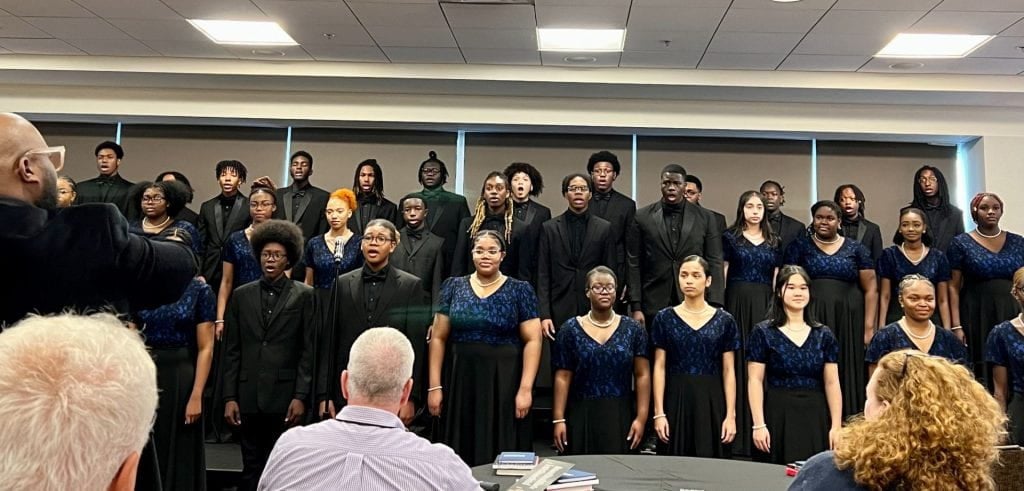 We started by listening to some amazing student singers from the M.E. Stilwell School of the Arts – Wow! It was a great kick-off – hats off to Dr. Morcease Beasely, NSR member and one of the local host superintendents!
We started by listening to some amazing student singers from the M.E. Stilwell School of the Arts – Wow! It was a great kick-off – hats off to Dr. Morcease Beasely, NSR member and one of the local host superintendents!

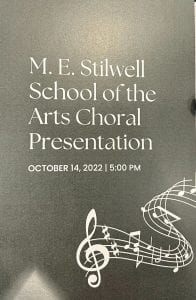
As a group, we reinforced our strongly held beliefs about the value of public education – the reality that we as superintendents need to lead & engage communities – and that we convened to learn, connect and reflect on the real trouble and challenges we face, and more urgently and more important, what our nation’s youth face!
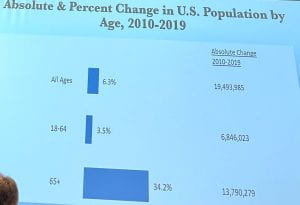
 We began by looking at demographics – facts tell the story – the world is changing. Thanks to Dr. James Johnson from the University of North Carolina for scaring us and inspiring us to realize that reality is … well – real.
We began by looking at demographics – facts tell the story – the world is changing. Thanks to Dr. James Johnson from the University of North Carolina for scaring us and inspiring us to realize that reality is … well – real.
Dr. Johnson illustrated to us that we are in the midst of a massive demographic transformation. We are in a disruptive demographic change. Transformation is and will impact K-12 and Higher Ed. These forces are and will also impact the US and the global economies.
Data shows that the Pandemic also had major demographic impacts. Dr. Johnson shared and showed the profound regional population redistribution in our nation.
Dr. Jim succeeded in helping us to create a common understanding of what’s happening around us – facts don’t lie – they illustrate realities.
What do young people need in their toolkits to weather the certainty of uncertainty?
Dr. Johnson posits, “We need people who can groove on ambiguity!”
Sharing some “notes” from Dr. Johnson’s lecture:
 1970-present, the South has captured a majority of in-migration.
1970-present, the South has captured a majority of in-migration.
Destination – added 22.7 Million during the 2010-2020 period
2010-2020–Who is coming to the South – “everybody”
NE and Midwest to West and SOUTH
Texas, Florida, Georgia, North Carolina, and Virginia – “migration magnet” states growing faster than the other southern states 79% of the share of in-migration in the South
What about during the Pandemic?
South gained about a million more people in 15 months of the Pandemic
Midwest lost 144K people
NE lost 449K people
West gained 80K people
 The South got “pandemic refugees” from Midwest and NE, and they stayed – they did not come back to NE or MW
The South got “pandemic refugees” from Midwest and NE, and they stayed – they did not come back to NE or MW
Dr. Johnson also emphasized how We also have the browning and graying of America
Highlights of his commentary on this topic:
- 1965 was a crucial year in immigration history
- Before this – law was related to racial/ethnic balance from 1900 – preference of white people to be blunt
- 1965 – Quota system that was regionally discriminatory to foreign people who were not white
- Nation managed the composition of the population via immigration laws
- In 1965 (coincidentally with Civil Rights Movement) – the Hart Celler Act of 1965 – eliminated immigration restrictions based on people who were previously not eligible to immigrate
- Immigration and Nationality Act of 1965, Immigration and Nationality Act of 1965 | US House of Representatives: History, Art & Archives
2000-2010 Census in the USA
2MM White, or 1.2%
15MM Hispanic, or 43%
4MM Asian, or 42%
The demographic shift is like a Gale Force Wind Dr. Johnson shares, transforming the workforce, the public schools, and the entire nation – people are leaving the Northeast and the Midwest.
Beyond the population shifts, the “color” of America is browning and graying as fewer white people are born and more people of color are born, more mixed-race marriages produce children, and more Americans live longer and “gray”. The demographic shifts have historic and policy foundations.
- Intermarriage in the USA 1967-2015
- Before 1967 it was illegal in the USA for black and white people to marry
- The growing role of immigration, the growing role of inter-racial marriage, browning and graying of America – 2 or more races is a category growing rapidly – not “neat little boxes” for people
- US Life Expectancy 1900 47.3, 2010, 78.3, 2030, 100
Right now, we have five Generations in the workplace – the implications are crazy!
Silver Generation – pre-boomer, Baby Boomer, Generation X, Generation Y, Generation Z
In addition to the demographic shifts, population/race/age, there is another factor Dr. Johnson shared:
He calls it “Disappearing & Rebelling”
- 2020 Census trend – slowing of total population growth in the USA
- Rate of growth – peaked in 1960, 18.5% growth, grown slower progressively in every decade since then, such that in the last decade, 7.4% growth. The second slowest rate of growth in the history of the USA since 1790; the slowest was Great Depression which was 7.3%
- Trends to continue to be lower
- Far-ranging implications for everything – changes are here and are coming
First 15 months of the Pandemic – the first time in history – we added less than half a million in 15 months – the first time we did not grow history by 1MM per year – this is PROFOUND
Total Fertility Rate is below 2.1 in the USA – need 2.1 to replace yourself (mathematical index) – we’re losing more humans than we’re getting – on a large scale
In 2018 deaths outnumbered births among whites in more than half of the nation’s 50 states
Deaths of Despair and Declining Life Expectancy – due to suicide, alcohol, and drugs – 90,000 drug overdoses in the first year of the pandemic, a 30% increase over 2019 – the biggest increase in overdose deaths – overwhelming
100K in 2021 (prime working age people 25-44)
COVID-19 impact on fertility. Estimated 300K population decline
Globally 10MM kids lost parents – became orphaned during the pandemic – 550K in the USA
The Great Resignation – increased labor activism – it’s real – the impact is far-reaching
There is a grand reckoning among us = create a new workplace – a new normal – make workers excited to stay – culture and climate
 Our next speaker was also inspiring and clarifying! Dr. Leslie T. Fenwick – from Howard University and the author of Jim Crow’s Pink Slip – the untold story of black principal and teacher leadership, took us to a powerful place in reckoning our American history, Supreme Court decision implications (Brown V. Board of Education 1954), and MORE!
Our next speaker was also inspiring and clarifying! Dr. Leslie T. Fenwick – from Howard University and the author of Jim Crow’s Pink Slip – the untold story of black principal and teacher leadership, took us to a powerful place in reckoning our American history, Supreme Court decision implications (Brown V. Board of Education 1954), and MORE!
She asked us and helped us contemplate our sense of urgency — to whom must we invest? Equitable educational opportunity & access to education – this is elusive in some locales – still, even today in 2022 – why?
Dr. Fenwick reminded us that a national treasure is at the Smithsonian US National Museum of African American History – there is vast and accessible digital access to PK-12 instructional materials! in schools across the nation! The truth must be told; the objective, fact-based journeys of our ancestors and the ancestors of our countrymen and women can be told and accessed by all.
In addition, she reminded us that the Pulitzer Center has resources as well, including the 1619 project and various perspectives in US history.
Dr. Fenwick called upon us to “bust myths.” “Let’s mine and disseminate accurate data! Let’s remove negative stories and statistics – let’s find assets, not deficits – for example, there are more Black men in college, 1.6MM vs. Black men in prison, 600K, in the USA – what are prevailing stereotypes? Need to “myth bust.”
Dr. Fenwick’s book, research, and US historical data shed light on our realities. She reminds us and calls us to follow historical facts, not myths. The landmark US Supreme Court decision Brown vs. Board of Education of Topeka, KS (1954) overturned the 1890s case of Plessy vs. Ferguson, which called “segregation” illegal. This policy was long overdue, and our nation is obviously better off due to this heroic and historic decision.
But … like physics laws, every action has equal (and often opposing) reactions. So while schools were desegregated and integrated by law/policy, there were also some profoundly negative implications. Dr. Fenwick illustrates in her book, and from US history, that as an unintended consequence of the Brown ruling, an entire class and multiple generations of Black educators were eliminated from America. This is a direct cause of today’s underrepresented educators of color across the nation.
Dr. Fenwick shares that 100K black principals and teachers were fired, demoted, and displaced from the 1954 Brown decision to mid-1970 – there was racist and political resistance to having black educators teach and lead alongside whites. Black educators were replaced by less qualified whites. 17 “dual system” states (Delaware to Texas) – Black peers were fired – this was a horrible consequence of the Brown decision.
This was not because the Black educators were less qualified. On the contrary, as early as 1926, the all Black faculty held Masters’s degrees, same in the 1930s – often they went North and earned degrees from higher ed universities. In the 1960s, after desegregation, white faculty had lower rates of master’s degrees. White superintendents and school boards were pressed to hire more educators; they turned to more whites and ignored and displaced existing and well-qualified Black educators. This was not the intent of desegregation. Turning desegregation into a “students only” situation exacerbated the lack of a Black educational force to work integrated alongside the white educators. This impacts us today.
Why today is there an underrepresentation of people of color in the nation’s schools and boardrooms, and principals’ offices – history illustrates this – policies fighting against the law of the land caused generations of Black teachers and principals to be deposed, displaced, demoted, and fired. They were removed from education. They have not returned! This is true history – not political, judgmental, ideological – simply the truth. And reckoning with the truth will be our only salvation and progression.
What does it mean to American schooling? Had these Black professionals been integrated into the post-Brown decision educational profession as integrated professionals, instead of being expelled, we would have a far different reality today – representation, legacy, history, reality. Would societal and institutional racism and racist policies have been so prevalent had the integration of schools been for both students and faculty? Would the need for so much “focus” on DEI today be necessary had the nation simply moved forward integrating adults and children?
A myth Dr. Fenwick busted is that Black educators did not “flee” education after Brown since they had more opportunities in the newly desegregated workforces – they were removed due to resistance to black educators joining white educators in a similar post-Civil War “reconstruction” era revision of the Jim Crow laws that took hold in the USA following the progressive 13, 14, and 15 Amendments to the US Constitution. One needs to look at the Hayes election in the USA and then dismantle “equality” policies with the 1899 Plessy vs. Ferguson case, with codified “separate but equal” was clear and equal was not.
We have the power to change trajectories for kids, communities, and our nation. Dr. Fenwick’s call to action is to simply learn, acknowledge, learn from, tell the truth, and transform our public schools (and society) to reap the rewards of democracy and to realize the vision of so many who fight for equality, equity, dignity, and the American ideals of life, liberty, and Pursuit of Happiness for all of us. Not just for some of us.
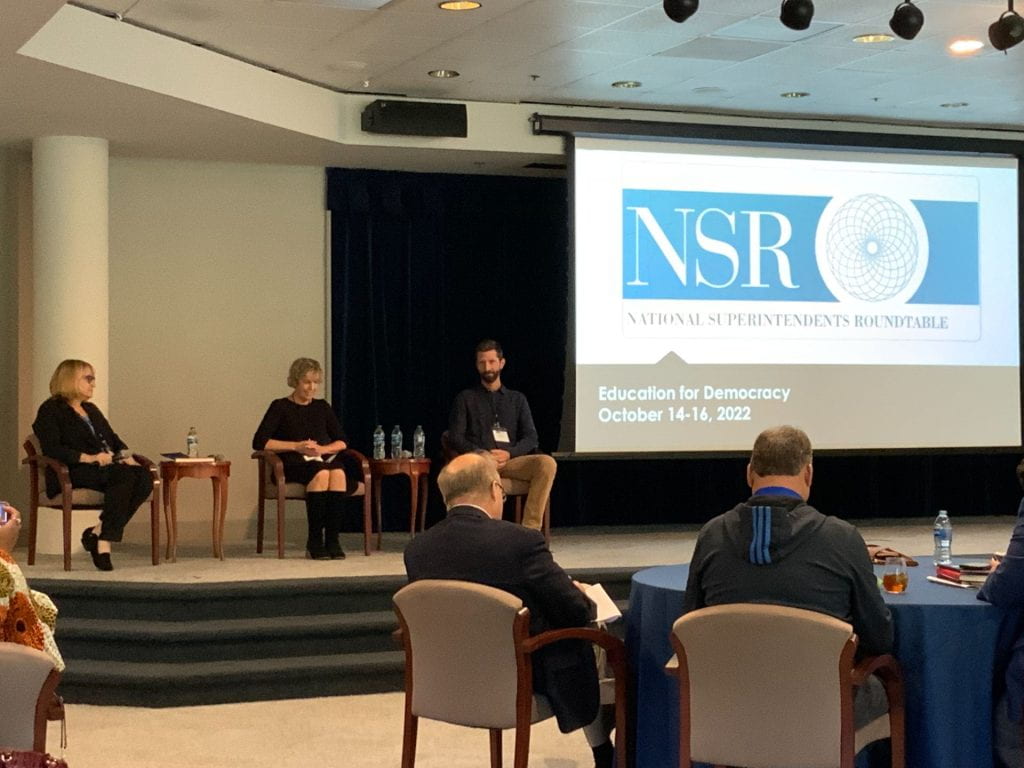
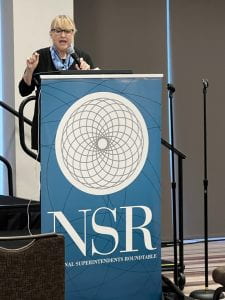 At this powerful conference, we also benefitted from Washington Post reporter Valerie Strauss and the authors of A Wolf at the Schoolhouse Door authors Jack Schneider and Jennifer Berkshire
At this powerful conference, we also benefitted from Washington Post reporter Valerie Strauss and the authors of A Wolf at the Schoolhouse Door authors Jack Schneider and Jennifer Berkshire
So what is a “good school” … continuing narratives about public school value – public school critical space in our society
They, too, call us to action with fact, not a myth; as an example, even though research shows that public schools have better outcomes than those in the private sector (check Univ VA research), some privatization folks claim the contrary.
They discussed: How is privatization affecting public schools, and why is this dangerous?
Advocates for parental rights & private school/choice – they want this to be a “litmus” test issue politically
Public education is in danger in many states (eg – Florida… Texas …)
Funding and widespread disinformation campaigns
We pondered, “What does the future of schooling look like?” Our aim and their directions for us is to try to make clear to people that the vision of an alternative to public education is NOT hyper elite – instead, a voucher system, for example, loses oversight, loses accountability, loses rights … etc.
We also had an incredible visit to the Jimmy Carter Presidential Library & Museum, sharing some cool pictures from that inspiring and eye-opening
- Communications in the early 1980s – Military Comms
- Treaty pen – Arms Limitation
- Carter’s Oval Office
- Carter’s Oval Office
- Secret Document – Afghanistan
- Great images
- Presidential Seal
- Powerful Quote
- Carter’s early influences
- Father of USA
- Selfie
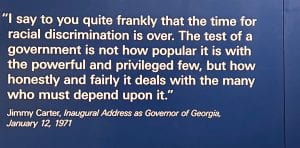
Reminder about 5o years of American history – on display!
The purposes of public schooling are inherent in promoting democracy and civics. The public school is the public institution where ALL gather.
So, as part of the evolving stories about “what superintendents do,” the essence is that we lead. We listen. We learn. We challenge ourselves to be uncomfortable and unfinished. And we, of course, help one another unlearn so we can relearn!












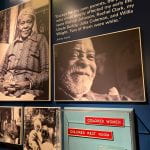





October 17, 2022 at 9:23 am
Excellent blog. Wonderful weekend of learning and new friendships!
Julie Lyon
October 17, 2022 at 9:27 am
Thank you so much, Julie – we have so much “good” we can share!! It was a powerful weekend.
October 17, 2022 at 9:27 am
Thank you so much, Julie – we have so much “good” we can share!! It was a powerful weekend.